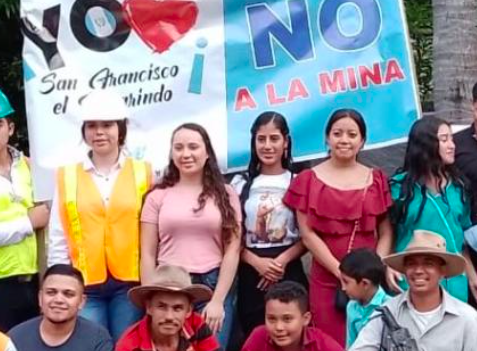 A municipal referendum was held on September 18 in Asunción Mita, Guatemala, that will impact the future of the Cerro Blanco mine. The question on the ballot aske
A municipal referendum was held on September 18 in Asunción Mita, Guatemala, that will impact the future of the Cerro Blanco mine. The question on the ballot aske
d people if they were in agreement with the presence of mining projects that would affect the natural resources in their territory, and the answer of the people was a resounding no.
Asuncion Mita is the capital of the eastern department of Jutiapa in Guatemala and is home to the Cerro Blanco mining project. Local communities and environmental organizations have long been concerned about the environmental impacts of this project on shared waterways in Guatemala, El Salvador, and Honduras. But years of frustrations about the lack of information on the project by government authorities and lack of prior consultation by company officials led local organizations to exercise their right to call a local referendum as outlined by article 64 of the municipal code.
According to the Municipal Code, any community can request a referendum from municipal authorities, on any issue that affects the public interest, if 10% percent of the registered voters sign a petition addressed to local municipal authorities. Once the petition is received, the local municipal council is obliged to put a process in place to consult the population. At least 20% of the registered voters must participate in the referendum for it to be binding.
From tunnel to open-pit mining: deficiencies in the Environmental Impact Assessment
In 2007, ENTREMARES S.A., a subsidiary of Goldcorp, obtained an exploitation license from the Ministry of Environment and Natural Resources. Yet, this Ministry had initially rejected the same environmental impact assessment (EIA) twice due to inconsistent information affirming that there would be no impact on the environment and the population.
Fifteen years later, the Ministry received an updated EIA presented by its new owner, Bluestone Resources. The 3545-page update details an open pit rather than a tunnel mining extraction process. Julio González, from the Guatemalan MadreSelva environmental collective, explained that “instead of an update, a process to present the EIA for the new, different project should have been open."
The company has publicly stated that there is local support for the project and that any opposition comes from external sources.” But last May, local organizations collected more than 4,000 signatures from registered voters to request municipal authorities of Asunción Mita to carry out a Municipal Consultation, as per art. 64 of the Municipal Code.
Historically, communities closest to mining projects suffer the worst consequences. At Cerro Blanco, the company has proposed a filtered tailings storage facility will be built in dangerous proximity to communities that would be banned in many countries as it risks being too steep and wet compared to mining industry standards.
An analysis of the Environmental Impact Study of the Cerro Blanco mine carried out by Dr. Steven Emerman, an expert in mining waste systems, recently published by the Heinrich Boll Foundation confirms the concerns expressed by environmental organizations. Dr. Dina Lopez, a retired vulcanologist from the University of Ohio, has also expressed concerns about the heat management models presented by the company in an ecosystem characterized by the prevalence of thermal waters; and Dr. Vladimir Pacheco, an expert on mining closure plans, said that he has concerns that the Environmental Impact Study does not present a closure plan, instead, it plans to start the process four years before the mine closes.
Mining operations’ solid and liquid waste will contaminate shared watersheds, worsen current water scarcity, and increase environmental vulnerability in Central America, says Jose Mario Lopez, of the Central American Alliance on Mining, a regional organization that supports mining-affected communities in the region and has been key in sharing advice to local organizations for the consultation process.
Salvadoran and Guatemalan Catholic Church representatives also issued statements of support advocating the protection of water as well as supporting the consultation process. According to González, "Pope Francis Laudato Si (2015) has been a considerable source of inspiration within the religious sectors in Guatemala.”
Preparing an EIA for a major extractive project always requires consulting the affected communities, but the lack of informed consultation in the extractive industry is a driver of socio-environmental conflicts in Guatemala. As González stated, “impunity and the trade of private interests is a characteristic of the mining industry.”
The Guatemalan Constitution (1985), ILO 169 (ratified in 1996), the Municipal Code (2002), and the United Nations Declaration on the Rights of Indigenous Peoples (2007) all recognize the rights of Guatemalan citizens to be consulted on important matters that could affect their lives and territories.
Sowing division in the communities
Following the results of the consultations where 28% of the registered voter participated and of those who participated 89.3% voted against the mining projects in their territory.
Bluestone Resources and the Ministry of Energy and Mines responded by issuing a public statement declaring the referendum illegal and not sanctioned by the government of Guatemala, however, local activists said that neither the ministry nor the company has jurisdiction over local consultations. “If the company wishes to have the referendum overturned, it must find a pro-mining group to initiate an injunction through a local court,” said Armando Teo, a local community organizer.
In that sense, a legal precedent established by the Guatemalan Constitucional Court in 2012 may be on the environmentalist's side as it ruled that these municipal consultation mechanisms are important because they make it possible to strengthen local democracy, promote transparency in the public administration, and are tools for citizens to exercise their democratic rights.
While Bluestone Resources attempts to obtain support from locals by investing in infrastructure, scholarships, and promises of employment, development, and economic growth, the company should realize that this approach risks sewing divisions as those who benefit from the mine’s presence will continue to find ways of criminalizing the will of the people.
